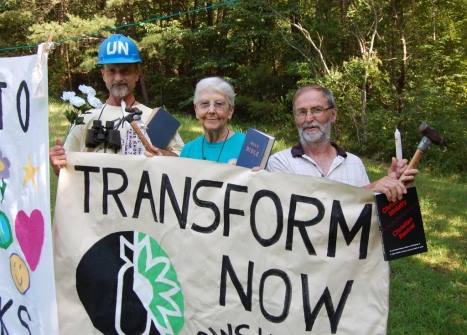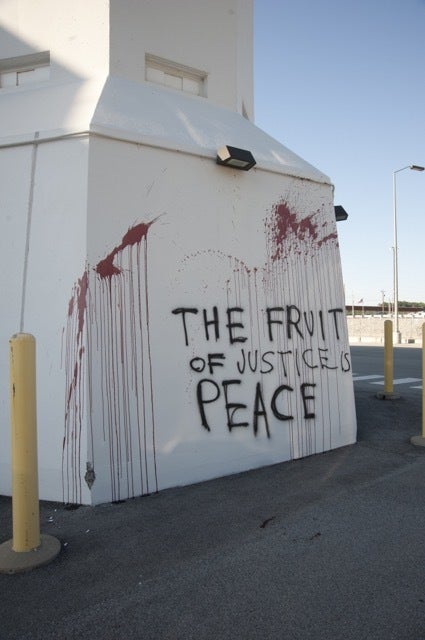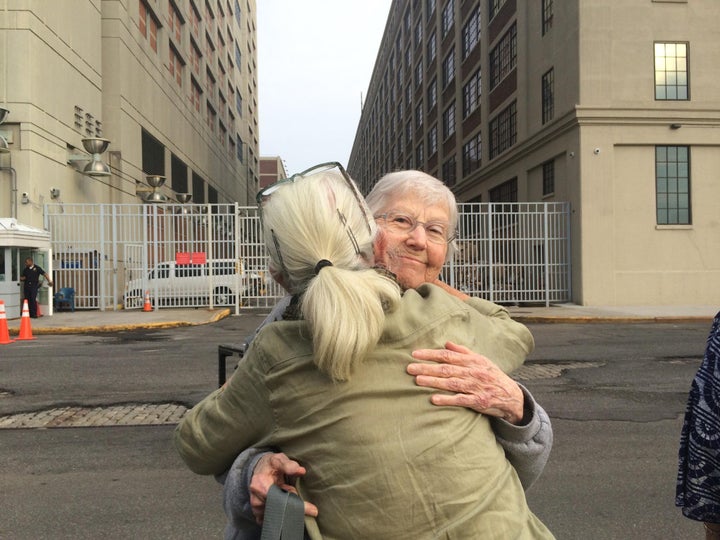America’s nuclear weapon launch codes and the question of whose fingers will or will not be in close proximity to them, is the subject of much debate these days. Undoubtedly, it will grow louder as the Presidential election moves into high gear this fall. As such it’s an opportune time for the publication of a new book: Almighty- Courage, Resistance, and Existential Peril in the Nuclear Age, written by Washington Post reporter Dan Zak and published by Blue Rider Press.
The shocking break-in at the Y-12 National Security Complex, America’s so called “Fort Knox of Uranium”, by an 82 year old Catholic nun and two fellow peace activists in 2012, is the precipitating event of this thoughtful examination of how the country’s bipolar mindset on nuclear weapons developed. Since they were first created more than 70 years ago in the quickly mobilized Manhattan Project, the top-secret national effort to beat the Nazis to an atomic bomb, America’s nuclear weapons have evolved from “a policy to a strategy to a faith,” observes Zak. He notes, “They would hasten doomsday, and also be credited with delaying it. “ Nuclear weapons “would remain the pinnacle of human ingenuity and insecurity, a force that binds American power and threatens to blow it apart, a paradox to be pondered and maybe, one day resolved,” Zak writes. But don’t expect that paradox to be resolved anytime soon because, as this meticulously researched book illustrates, there’s just too much money involved.

From a spending standpoint nuclear weapons have been America’s third largest priority exceeded only by non-nuclear defense spending and social security. Since Trinity, the first atomic bomb test lit up the New Mexico sky on July 16, 1945, some $10 trillion have been spent on nuclear weapons, says Zak. And the money being poured into them is expected to grow dramatically over the next 30 years. On tap for the future: the complete modernization of the nuclear weapons arsenal: ICBMs, submarines, and nuclear capable bombers with an estimated cost of $1 trillion. Hopefully, this anticipated new national investment will merit a question or two in the upcoming Presidential debates.
For Sister Megan Rice, the octogenarian nun who’s at the heart of Zak’s book, every dollar spent on a nuclear weapon is one robbed from society’s most vulnerable, i.e., the American underclass living in poverty, and suffering from inadequate healthcare, housing and education. The Sister believes the money flow also serves to boost the weapons’ “idolatry” in the national consciousness. Four separate Congressional hearings were held to investigate how a trio that carried no weapons (unless you consider a couple of bolt cutters, to be weapons) was able to penetrate one of the most dangerous places on earth and reach the outside walls of the very building housing the bulk of America’s highly enriched uranium. The storage facility, known as the HEUMF, has the capacity to store some 400 metric tons.

As Zak recounts in his book, during a break at one of the Congressional hearings, Sister Megan approached retired Major General C. Donald Alston, the former Air Force assistant chief of staff for strategic deterrence and nuclear integration who was called as an expert witness. She handed him a letter calling for the immediate suspension of funding for Y-12’s Uranium Processing Facility (UPF). The UPF is a new building being designed at Y-12, originally budgeted to cost between $600 million and $1 billion back in 2005. But by 2014 the price tag had skyrocketed to $19 billion. Cost overruns included the discovery, after seven years into the building’s design, that the envisioned ceiling was too low and needed to be 13 feet higher to fit the necessary equipment. That belated realization added $540 million to the design cost.
“The whole thing can be solved by changing the mission,” Megan said to the major general. “Change the mission, brother.”
“We have a lot of stability in the world because of nuclear weapons, said Alston, smiling, towering over her in uniform.
“It’s impossible to even secure one,” Megan said. “We can change the mission. It’s possible”.
“Okay,” he said.
“We can have projects that sustain humanity.”
From: Almighty-Courage, Resistance and Existential Peril in the Nuclear Age by Dan Zak.
While security experts and lawmakers on Capitol Hill tried to fathom how a pacifist trio could overtake a $150-million-a year security apparatus, the elderly nun along with veteran activists Greg Boertje-Obed and Michael Walli were convinced they had been led into the belly of the beast by the Holy Spirit. Zak’s book offers a moment- by- moment account of the planning for the daring undertaking, the challenging climb through brush, the cutting of the chain link fences, and the trio’s own incredulity at reaching as far as they did. Theirs was a Plowshares action, involving carpenter hammers and baby bottles filled with blood. Those are symbols of the activists’ desired conversion of the billions of dollars spent at our nuclear weapons complexes, from death dealing to life sustaining pursuits.
Zak paints a sweeping historical portrait of anti-war activism starting with Dorothy Day and the subsequent Plowshares movement. Some 100 Plowshares actions have taken place since 1980 when the Catholic priests Dan and Phil Berrigan undertook the very first one at a nuclear weapons plant in Pennsylvania. Then too, a Catholic nun, Sister Anne Montgomery from the Society of the Sacred Heart, would take part along with five others. They risked arrest and prison time and did so repeatedly in subsequent actions. Since then dozens of other people, both in lay and religious life, would follow suit- all in an effort to raise consciousness and pull the world back from the nuclear brink. But in the wake of the 911 terrorist attacks, the stakes are getting higher for people of conscience.

Sister Megan, Greg, and Michael were charged with sabotage when they refused to plead guilty to a lesser charge. The book takes you inside the trial, with portraits of the two Catholic prosecutors, and members of the jury. Ultimately, the three defendants are convicted and the judge faces a dilemma of whether or not to jail them pending sentencing. Months later the three are sentenced to prison time ranging from three and a half to five years. That’s followed by the dramatic overturning of their sabotage conviction. The twists and turns of this fascinating story are numerous, though the money aspect remains depressingly constant. During the trial the private contractor managing Y-12 placed the cost of damages caused by the trio’s incursion at around $8,500. But that was before additional expenses were factored in, including a charge of $114 an hour for five carpenters to make repairs. The final bill: $52,953.
Helen Young is producing a documentary examining two recent federal cases against nuclear disarmament activists including Sister Megan Rice.
